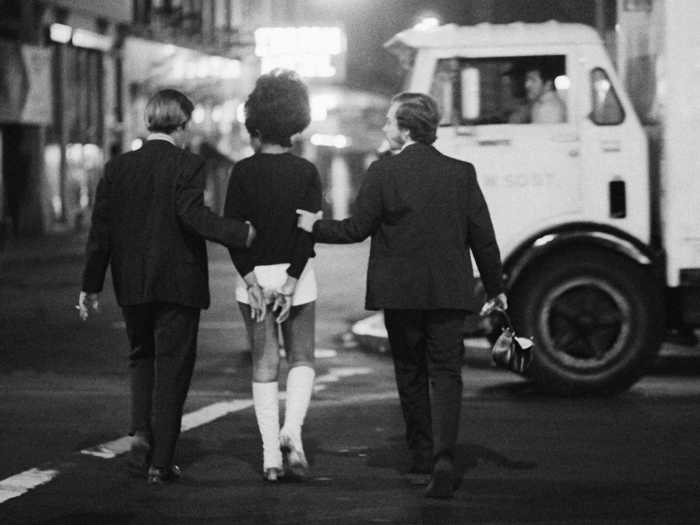
Two members of NYPD's "Pimp Squad" arrest an alleged prostitute in Times in Square.
Source: Publication of New York Women in Criminal Justice in collaboration with the Prostitution Task Force

The Hotel Belmore in Manhattan marked the end of Karen Baxter's life. As 15-year-old runaway from Cambridge, Mass., she resorted to prostitution to survive New York City until one of her customers choked her with a metal chain in 1975. The photo was taken five days after her murder.
Source: Publication of New York Women in Criminal Justice in tangent with the Prostitution Task Force

Barrows ran Cachet, a high-end escort-service from 1979 to 1984.
Source: Publication of New York Women in Criminal Justice in collaboration with the Prostitution Task Force

A poster advertises a peep show in Times Square, the epicenter of the sex industry in New York City, in 1981.
Source: Publication of New York Women in Criminal Justice in tangent with the Prostitution Task Force

This photo from 1971 shows three vials of pure heroin. By the 80s, Bryant Park became known as "Needle Park," due to the used syringes strewn across the ground. Heroin abuse didn't decline until the 90s.
Source: Drugpolicy.org

A crack house in the South Bronx sold this vial for five dollars in 1989.
Source: National Institute of Drug Abuse



Source: New York Times

Source: New York Times

Source: New York Times

Source: New York Times

Stanley Patz—Etan's father— and his son Ari hold a photo of Ian on the fire escape of their home. Investigators began searching a basement near the Patz' home in 2012, but they never found the boy's remains.

Graffiti even covered Grand Central Station, shown here in 1973, the most popular subway stop in New York City.
Source: New York Times

In the first two months of 1979, six murders occurred on the subway. Nine occurred that whole year. By September 1979, the police recorded over 250 felonies on the subway every week, the highest crime rate for any mass transit network in the world.
Source: NYCsubway.org

A transit officer tries to stop a man from handing out leaflets protesting the rise in New York City subway and bus fares from 35 cents to 50 cents in 1975. Turn-style jumping reached an all time high in the 70s.
Source: NYCsubway.org


Police escort Jason Ladone, center, 17, one of four teenagers charged in connection with the death of Michael Griffith. The Trinidad-born man was run down on the highway by a car and killed.

Five teens went to prison for the crime. But 13 years later, a convicted rapist named Matias Reyes admitted he alone attacked the jogger. Reyes became known as the "Central Park Jogger."


Source: NYC.gov

Source: New York Times


Brown believed in cops walking the streets, getting to know people, and solving problems — rather than just responding to 911 calls. After one year of his position, crime decreased in every category.
Source: Harvard Business Review


Crime also fell 33% nationally. Berkeley Law professor and author of "The City That Became Safe," Frank Zimring gives Giuliani "derivative credit" for making New York safer. What he calls the "great American crime decline" had a huge effect, as well.
Source: Politifact

 Hardik's T20 WC ticket hinges on his IPL form: Sources
Hardik's T20 WC ticket hinges on his IPL form: Sources
 India's gold demand up 8% in Jan-Mar to 136.6 tonne despite high rate
India's gold demand up 8% in Jan-Mar to 136.6 tonne despite high rate
 Mahindra XUV 3XO compact SUV launched in India starting at ₹7.49 lakh
Mahindra XUV 3XO compact SUV launched in India starting at ₹7.49 lakh

Copyright © 2024. Times Internet Limited. All rights reserved.For reprint rights. Times Syndication Service.